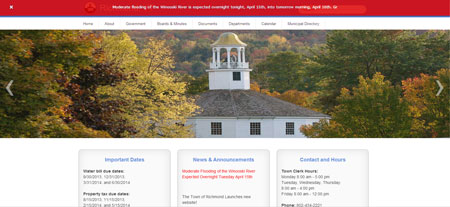This article was written by Tess Gauthier, Project Mangerat the Snelling Center for Government

In the last newsletter, I provided an update of the Snelling Center for Government’s work on 15 municipal websites as part of the Vermont Digital Economy Project. And, previously, we’ve discussed the community process by which we work with towns to determine what’s important to include on a town’s website. Another aspect of our municipal website project is the thoughtful manner in which we designed a functional WordPress template for Vermont towns. This work is already making an impact in Vermont’s flood-damaged communities.
Some of the features we’ve built into the new websites are for economic development, such as the integration of online payments; some are for the convenience of residents or to increase their engagement, as with an integrated community calendar; and others are for town web administrators, like the integration of Google analytics and the ability to simply and more easily make updates to web content.
Given that we are funded by a disaster relief grant and that we prioritize our activity in flood-damaged communities, the emergency notification features on the site are some of the most important aspects of the template we created. After researching what leaders in municipal website management were doing and listening to town officials describe the experiences and challenges they faced to communicate with citizens throughout Hurricane Irene and the Spring Floods of 2011, it was clear that at bare minimum the template should provide flood-impacted towns with the ability to seamlessly communicate emergency information to their citizens.
Thanks to this research, we integrated the two most important features for emergency communication into our template: a Homepage Notification Banner which can be activated during emergencies, such as severe weather conditions, and an add-on which enables the town’s web manager to update the homepage by simply sending an email.
The Emergency Notification Banner is a WordPress plugin that enables towns to quickly input the message they need to get to residents. When activated, the colored banner drops down over the top of the site’s homepage, quickly allowing any site visitor to register the important information displayed there. It is appropriate technology for rural and mid-sized towns and provides a foundation from which towns can grow as they adopt and integrate other forms of communication. The banners allow towns to easily link to their Twitter or Facebook accounts, directing users to platforms that are more suited for emergency communication. The towns can choose their own color for the banner.
One of the town websites that we launched most recently was for the Irene-impacted town of Richmond, in southeastern Chittenden County. The timing for the new website launch couldn’t have been better. Within days of the website launch, Richmond officials used the emergency banner functionality of their new site to alert area residents to severe flooding.
Geoffrey Urbanik, Richmond’s Town Manager said, “The enhancement to our town website made a real difference. We had several Richmond residents contact our office to thank us for providing proactive communication about the flood warning.”
The Emergency Notification Banner can be very effective, but it’s also important to keep in mind that it is essentially a one-way communication because the resident has to visit the town website in order to see the emergency information. To take emergency communication to the next stage, Vermont towns can begin integrating social media into their emergency communications plan. They can also look into other options, including adopting software that enables text notifications to town residents, and tying into Vermont’s new emergency response system.
